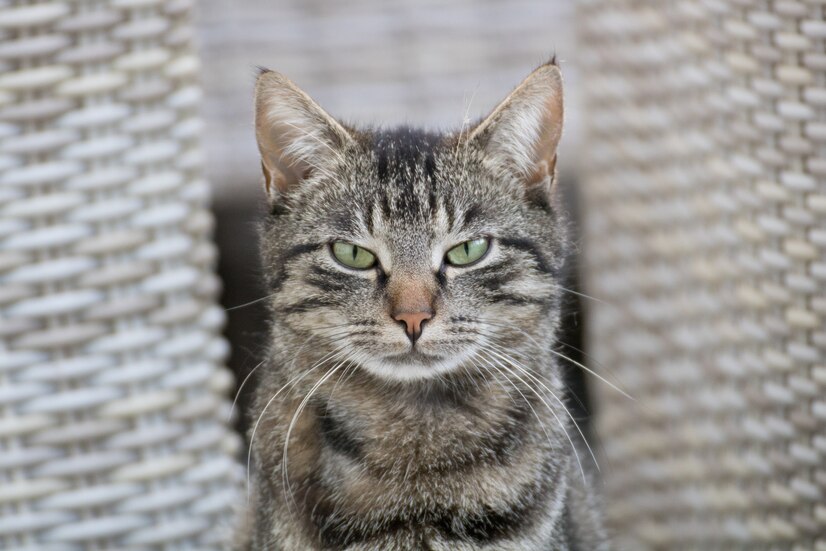Most cats communicate their fury by a range of sounds, just as people do. These unique warning sounds are not just random noises; they are deliberately crafted signals that cats have employed for thousands of years to protect themselves and communicate with one another. Read Can cats see colors?
Each sound has a distinct meaning and level of warning, assisting other animals and people in determining the gravity of the issue.
5 Angry Cat Sounds
The Famous Hiss
The hiss is the most recognizable angry cat sound. It’s a piercing, furious roar that sounds eerily similar to an agitated snake, and there’s a reason for this. When cats hiss, they emulate one of nature’s most terrifying monsters. The sound originates deep in their throat and emerges in a powerful blast of air, frequently revealing their teeth at the same time.
Read Why Does My Cat Follow Me To The Bathroom
Cats make this sound when they are cornered, afraid, or feel threatened. Even the most fearless dogs will back away when they hear a cat’s serious hiss. Most cats reserve their hisses for critical situations, knowing that it is one of their most powerful warning signals.
The Growl
A cat’s snarl betrays its wild ancestry, reminding us that our domesticated cats share DNA with lions and tigers. This loud, frightening rumbling originates deep within their throat and chest. Unlike a brief hiss, a growl might continue several seconds or even minutes if the cat feels threatened. When cats growl, they are not merely alerting others; they are also demonstrating their willingness to defend themselves if required. Read Can Cats Eat Rice? Top Answer Of 2024
If the threat persists, the sound becomes louder and deeper, and many cats will respond with greater aggressive behavior if their growl is ignored.
The Angry Meow
The angry meow is very different from the lovely noises cats make when they desire food or attention. These angry vocal messages are significantly louder, longer, and more intense than typical meows. They frequently come out as a harsh, drawn-out “MROOOW!” that may sound unpleasant to our ears.
Cats utilize aggressive meows when they are really agitated or outraged about anything specific, such as when another cat invades their territory or when they are treated harshly. The sound frequently begins high-pitched and ends in a lower tone, distinguishing it from welcoming meows.
The Spit
A cat’s spit is a loud, explosive sound that can take people by surprise. This piercing “pfft!” sound is typically the first warning indicator before more dangerous sounds occur. Consider it your cat’s fast way of expressing “Watch out!” without engaging in full attack mode. Cats frequently produce this sound when something frightens or irritates them, and it is usually followed by a fast backward hop or head movement. Read Can Cats Eat Watermelon? Benefits, Risks, and Vet-Approved Tips
While it may appear less serious than other angry sounds, a spit should always be interpreted as a strong indication that your cat is displeased.
The Yowl
When heard in the dark at night, the yowl is possibly the most eerie of all cat sounds. When paired with other angry sounds, this prolonged, loud cry conveys intense distress or fury, however it can also imply many other things. Compared to ordinary yowls, angry yowls are deeper and more menacing, and they frequently last for several seconds. This sound is especially prevalent when cats are fighting or believe that their territory is in danger.
Cats can effectively warn people to keep away without having to approach them since the yowl can travel great distances.
Why Do Cats Make These Sounds?
Cats evolved these different noises during thousands of years of evolution. They use them in specific situations: when they feel threatened by other animals or humans, when they need to defend their territory from invaders, when they are in pain or distress, when they are trapped or cornered, or when they are attempting to warn off other cats.
Reading Your Cat’s Body Language
Angry sounds never arrive alone. Cats use their entire body to express their emotions. When a cat is agitated, its fur rises up (particularly on its back and tail), making it appear larger and more frightening. Their ears flatten against their skull to protect them in the event of a conflict, and their tail may expand to twice its normal size. Their eyes frequently constrict, and their pupils can become very tiny or very broad depending on how scared they feel. Read 9 Reasons Why Do Cats Hate Water?
These bodily indications, together with their vocal warnings, provide a comprehensive picture of their emotional state.
What To Do When You Hear These Sounds
Responding appropriately to furious cat sounds is critical for both human and feline safety. The best way is to let your cat lots of space and time to relax. Never try to pick up or calm an angry cat; this usually makes matters worse and may result in scratches or bites. Instead, ensure that they have a clear escape route and a safe location to hide. Remove any triggers if feasible, and wait until they show indications of calm before approaching again.
When to Be Concerned
While furious sounds are typical at times, unexpected changes in your cat’s behavior require attention. If your normally quiet cat begins making frequent furious sounds, they may be sick, in pain, or worried about something in their environment. Look for trends in when these sounds occur. If they occur frequently or you are unable to determine the source, you should speak with a veterinarian to rule out any health issues.
Read Further
How to Punish a cat for Pooping Outside the Litter Box



